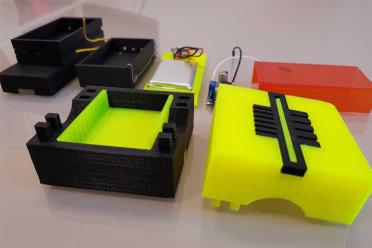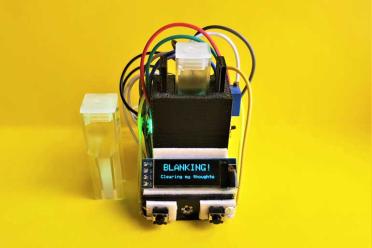Cristina Cipriano: Open source biology by 3D printed design
Replicable, affordable and simple 3D printed designs promoting open access and open science anywhere in the world.
I was delighted to meet Cristina at last year’s Thought for Food Global Summit, where she joined us along with a small army of science-enthusiasts looking to revolutionise how we think about, communicate and champion scientific discovery.
Cristina does some amazing work in the scientific community, making replicable, affordable and effective tools that are also hackable, meaning that anyone can access and use them to do real science anywhere on the planet using only simple equipment.
Rather than tell you about it myself, I asked Cristina to take us on a journey through her incredible designs, and her wonderful attitude to open science and creative thinking, for the good of society and scientific literacy.

Persistent polymath, enthusiastically and avidly exploring the intersections where fields of knowledge merge. As a biologist, she's working on projects involving basic research, informal science and public outreach, all aimed toward providing a clearer outlook on the scientific process in general. Former intern at the Italian National Research Council (CNR), she is now a budding molecular biologist and electronics devotee combining wetware, software and hardware. Cristina is the first Italian to have built a biology laboratory in her home and is well-known for her minimalist, low-cost and open-source scientific equipment designs. She is board member at Binomica Labs, an independent research group based in New York City, devoted to scientific practice and scienctific curricula development for students of all ages and backgrounds. She is also founder and former editor-in-chief of the Italian science journal Il Positivismo, as well as a MOOC-addict and well-rounded nerd.
Hi Peter! The colorimeter is part of an expanding library of simple, easily-made science equipment that can be 3D-printed and cheaply sourced. I’ve set a goal to make a new tool every month of 2018, which I’ve been doing so far. After these twelve “horcruxes”, the plan will be to design and actually build a rather ambitious universal laboratory robot out of my older Anet A6 3D-printer. There is much to be learned from the field of bioprinting but I also want to give my wrist a break, so I’ll definitely want to add a pipetting platform to the device.
From a more applied perspective, I’ve been working on some automated bacterial turbidimeters, a conductivity meter pen and even a Minimalist Laser Microscope. Just having the ability to project the microworld inside a tiny drop of liquid onto a wall, as a living wallpaper, led to a whole new way of experiencing microscopy and science in general. This concept has been a theme in all my designs going forward.
One of my favourite builds so far is an electrophoresis chamber I made from a Tic Tac candy box. The clear orange plastic material seemed identical to that used to filter out blue light for visualizing DNA agarose gels. Considering how specific the light filtering plastic must to effectively block the blue light from the transilluminator, I wondered if I could work around that box and fit a gel in it. It turns out you can! By using off-the-shelf electronics and a bit of stainless steel wire, I assembled a crude prototype and ran some DNA ladder sample using a 3D printed gel casting tray I designed.
I was blown away that all this worked and the best part of it all was that it ran on a much lower 30V potential, so it was far safer to experiment with than the typical 100V DC. I’m working to finish up the design of a very modular and portable gel electrophoresis system that runs off a rechargeable lithium ion battery pack with a back-of-the-envelope run time of 10 hours on a single charge (200mA run, 20 minutes per gel, 2000mAH battery).

What I’m most excited about is a design I’ve been toying with involving one of the most vital tools in molecular biology: a PCR machine! Sticking to the established theme of cheap, simple, and ideally rechargeable, this tool will take advantage of some easy assemblages involving coils of heating wire that, if successful, could eliminate the need for machined aluminum tube blocks entirely, with some added perks.
Let’s not understate the wow-factor: it’s a machine that can print physical objects in a matter of hours… how cool is that?! I can take an object that I imagine in my mind, draw up the dimensions, and then a machine lays down plastic into the exact form I need. In some ways, we are already living in the future, so why not own a tool that can print, therefore generate, other tools?
The first thing that surprised me was how dramatically affordable 3D printers have become, not to mention the fact that they can come as kits too, allowing me to purchase and assemble one of the cheapest models on the market.
Another big aspect in convincing me to buy a 3D printer was knowing how much help I could find. I had less than zero experience with any of this, so knowing I had some sort of “safety-net” definitely helped. Along with the 3D printer itself, what really changed the way I felt about making things in general was stumbling upon a program called TinkerCAD. This is a browser-based 3D modeling platform that is so intuitive a kid with no experience can pick it up and start modeling in a matter of minutes.
Being able to take an idea and turn it into a tangible object in a few hours is such an empowering concept. I felt as if I just learned to speak a new language and in time the clumsy manipulation of shapes became second nature and the ideas came flowing in. Building your own tools implies the added bonus of understanding how they work on a deeper level and gives you confidence to use them without the fear of not being able to fix them. This is the main reason why I wish to see kids using these technologies at an early age. It could even give some opportunities for parents to bond with their children and learn something totally new, together.
I regularly find new ways of challenging myself. In this specific case, my goal is to get to the heart of common lab tools and distill their essence down into very basic components. To figure out how to improve designs with simple yet elegant solutions. Once the underlying mechanism is clear to me, the next step is hunting for parts to make the solution accessible to the most possible people. I have no interest in building a fancy machine if few have the parts or skill-set needed to replicate it.
Getting tools to work well with the bare minimum, possibly for a very reasonable cost and maybe even better than most expensive ones, can have a significant impact on our society.
As humans we have a need to explore and embrace change, thus we are constantly redefining what a workspace is. A lab is about the people as much as it’s about the science and not all research can be or should be exclusively done in formal laboratories. There are plenty of questions one can investigate in remote areas or developing regions, where access to scientific machinery is more of a privilege than a commodity.
Keeping in mind that tools should accommodate our necessities, not vice versa, I envision the lab of the future as one that meets people’s needs wherever they are and, as it becomes more distributed, portability and simplicity will play a crucial role.
I don’t think my ideas are necessarily the best solutions out there, they are meant to challenge others as well. Sometimes we don’t even attempt an idea because we start thinking it may not be feasible, but we should.


Just having the ability to project the microworld inside a tiny drop of liquid onto a wall, as a living wallpaper, led to a whole new way of experiencing microscopy and science in general.

The creative mind emerges from experience, after being exposed to certain processes. Once you start learning how to think creatively, ideas will be all around you and will emerge anytime. For example, the concept for the Tic Tac electrophoresis system came to me while waiting in line at a supermarket! The candy box caught my eye and the exposure I had to the concepts and tools of gel electrophoresis helped me put the two ideas together.
I never think of myself as half decent at design, let alone “good”, and there is plenty of room for improvement. I merely try to come up with what I believe is a logical solution that is both functional and practical for the user. These design ideas tend to manifest out of my own frustrations with the current tools available to me, so a lot of the modifications and reworkings I apply are driven by things that I feel could be done differently. I have no formal training in design engineering, so I follow common sense and my instincts, which seem to result in a usable tool more often than not.
The initial versions of my designs are all open source and tend to end up as long-winded posts on Thingiverse, a platform for hosting 3D printable objects in a standardized format. More refined versions will be sold in the future as affordable kits, but the design files themselves will be open source after submitting the tools as publications on bioRxiv.
The internal components of these devices are designed in a modular and hackable way, so the only true limitation is really just your imagination. I want anyone and everyone to be able to make these devices their own by modifying components. All I ask is that they post their modifications and make those available to the public as well.
Many of the tools I am building are being used to conduct some interesting at-home science, involving the adored bioluminescent bacterium Aliivibrio fischeri, focusing on metabolism and growth. If I can create publishable research using these instruments, others could have more confidence in using them as well for both educational purposes and publication-grade research.

A closed source design does not grow and evolve as fast as one being curated by a community. This concept of a “living design” could not exist if they were kept closed source. I care as much about the community as I do about properly documenting these instrument tutorials, and I feel being able to alter the schematics as one sees fit is an incredibly empowering idea.
By providing the bare minimum of functionality, you lay down the foundation for future improvements, with unique features borrowed and remixed from others in the community.
Widespread access to the tools of science will result in more people getting involved and sharing what they’ve learned with one another. Distributing the research load across a larger community will also improve our chances of developing solutions to problems.
By making the means of scientific exploration open-source, we allow these tools to evolve long after the inventors stop working on them.
Making the tools to conduct scientific experiments affordable and accessible allows anyone studying the topics to have a hands-on supplement to what they may be learning formally.
Many schools, even at the university level, often lack the resources to fully immerse every student with a practical skill set to complement the otherwise abstract theory they are studying. For example, much of molecular biology is invisible to the naked eye and is seldom tangible, so giving the student their own personal toolkit increases the chances of them understanding the technologies that make these powerful techniques function.
These tools are not limited to just students. I’ve spoken with established researchers who find some of these portable instruments very attractive especially for field work, where access to a formal laboratory and full-sized benchtop equipment is out of the question. I believe there’s an intrinsic elegance in simplicity, quick tests with simple tools could make a researcher’s life a lot easier.

By making the means of scientific exploration open-source, we allow these tools to evolve long after the inventors stop working on them.

I don’t think anything I do is beyond the capabilities of anyone willing to put in the effort and time. I believe my work can have some small contribution to the overall grand challenge of spreading scientific literacy. I see scientific reasoning as one of the many means available at our disposal to really overcome the barriers that hold back progress. I don’t mean just technological progress, but the shaping of a generation of critical thinkers who can really mold society in ways we can only begin to understand.
My aim is to help keep people’s curiosity alive and reshape their perspective on science to a more accessible and curiosity-driven inquiry. “Don’t let your schooling get in the way of your education”, as Twain said, but also don’t let any geographic or socio-economic factor get in the way of what you can do. I strongly believe that curiosity-driven research could produce dividends that are both unexpected and much needed going forward, since it allows passion to be at the forefront of the difficult but rewarding task of generating new knowledge.
On a more personal note, I know there are plenty of shy people out there who won’t necessarily speak up about their curiosities, so working toward a more inclusive and inviting environment is just as important. As a society, I hope we can learn to embrace the different ways people learn and interact, so that no one feels left out. I know the struggle all too well, but if we all work together toward a more evenly distributed, collaborative future, there will eventually be a generation that has creativity and collaboration hardwired into them. The world may not need more humans but it certainly needs more humanity.
There will definitely be more tools on the horizon covering all of the things needed for a very basic molecular biology lab. In time I’d also like to dabble in other fields of science, since my passion is far from limited to biology alone. I am still learning and am in many ways a scientist-in-progress, so I can never be certain where I’ll end up next. Wherever my interests take me, I’ll be sure to document thoroughly and share my findings in case others of a similar mindset wish to join the fun!